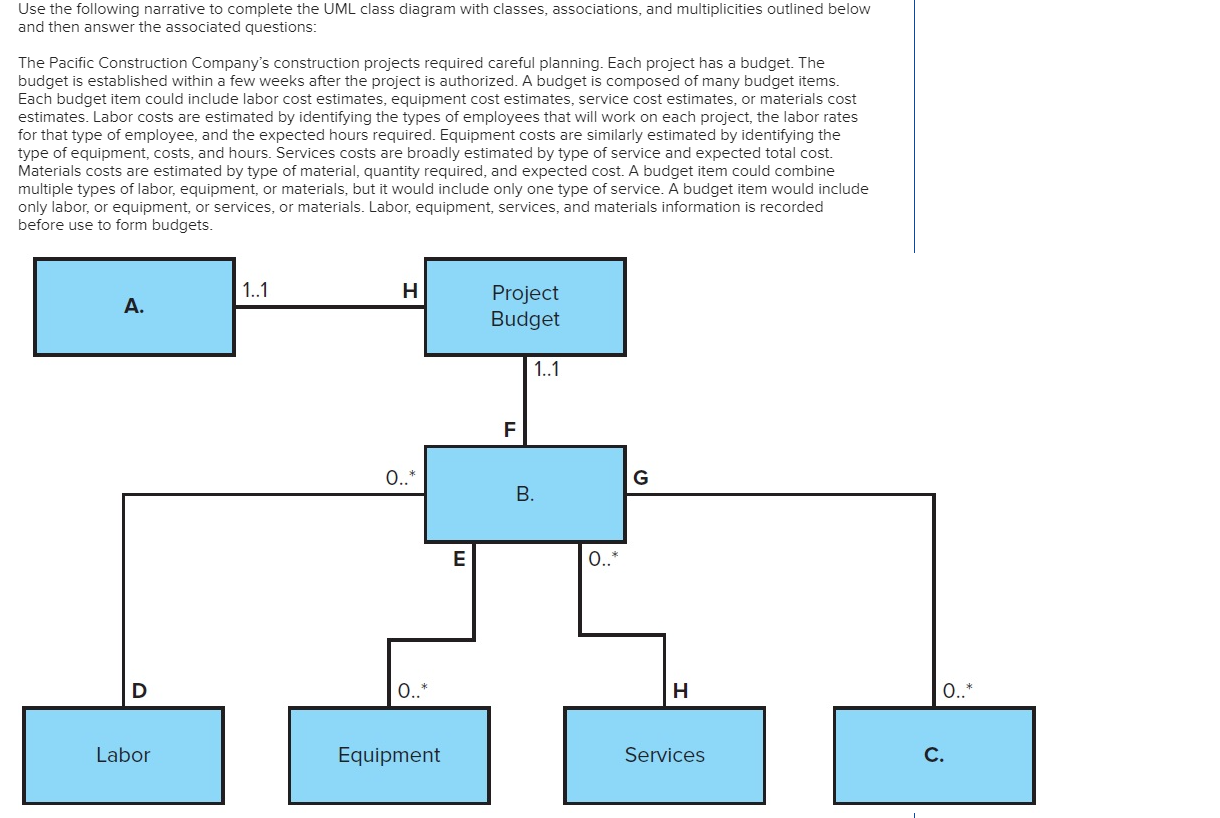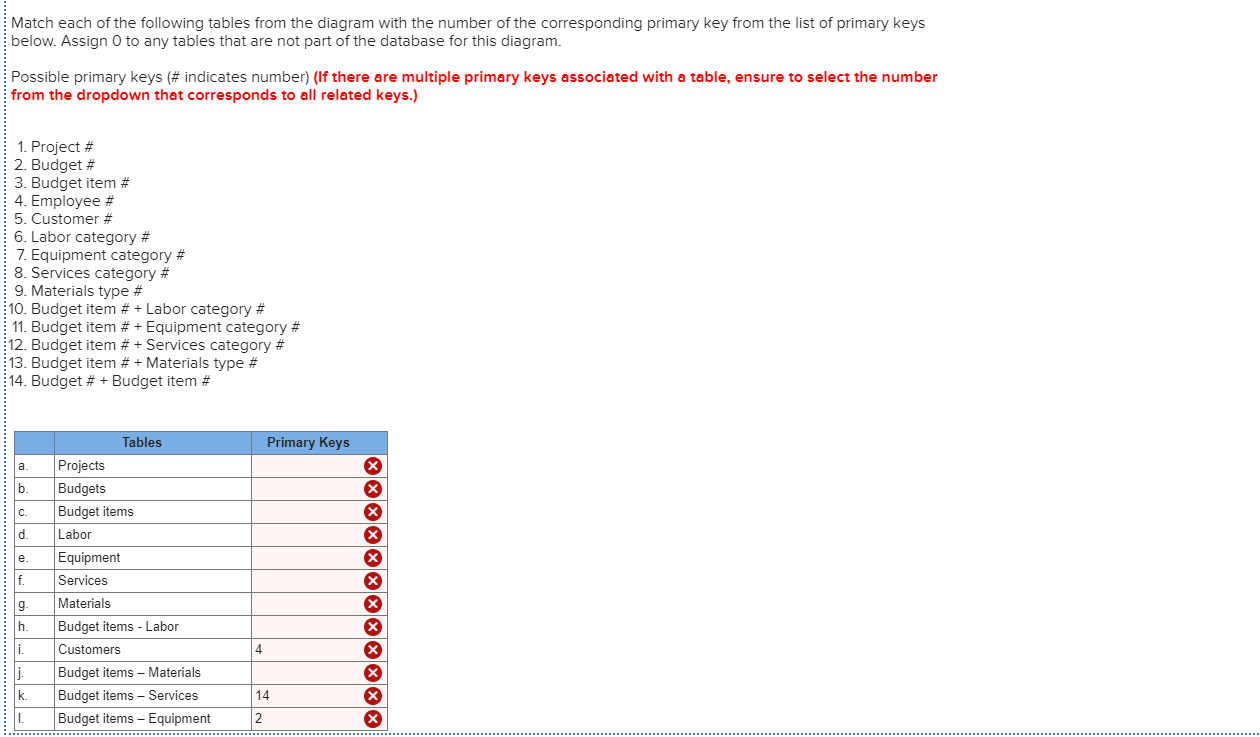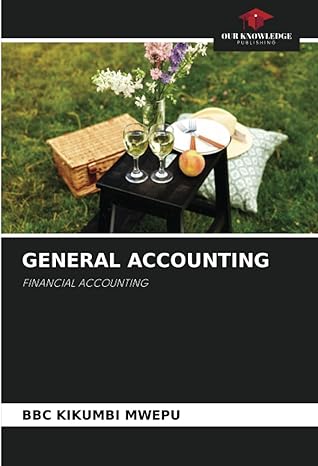

Use the following narrative to complete the UML class diagram with classes, associations, and multiplicities outlined below and then answer the associated questions: The Pacific Construction Company's construction projects required careful planning. Each project has a budget. The budget is established within a few weeks after the project is authorized. A budget is composed of many budget items. Each budget item could include labor cost estimates, equipment cost estimates, service cost estimates, or materials cost estimates. Labor costs are estimated by identifying the types of employees that will work on each project, the labor rates for that type of employee, and the expected hours required. Equipment costs are similarly estimated by identifying the type of equipment, costs, and hours. Services costs are broadly estimated by type of service and expected total cost. Materials costs are estimated by type of material, quantity required, and expected cost. A budget item could combine multiple types of labor, equipment, or materials, but it would include only one type of service. A budget item would include only labor, or equipment, or services, or materials. Labor, equipment, services, and materials information is recorded before use to form budgets. 1..1 H A. Project Budget 1..1 F G B. E 0..* D 0..* H 0..* Labor Equipment Services C. Match each of the following tables from the diagram with the number of the corresponding primary key from the list of primary keys below. Assign 0 to any tables that are not part of the database for this diagram. Possible primary keys (# indicates number) (If there are multiple primary keys associated with a table, ensure to select the number from the dropdown that corresponds to all related keys.) 1. Project # 2. Budget # 3. Budget item # 4. Employee # 5. Customer # 6. Labor category # 7. Equipment category # 8. Services category # 9. Materials type # 10. Budget item # + Labor category # 11. Budget item # + Equipment category # 12. Budget item # + Services category # 13. Budget item # + Materials type # 14. Budget # + Budget item # Primary Keys a X b. C. d. e. f. Tables Projects Budgets Budget items Labor Equipment Services Materials Budget items - Labor Customers Budget items - Materials Budget items - Services Budget items - Equipment g X h. X i. 4 j k 14 2 Use the following narrative to complete the UML class diagram with classes, associations, and multiplicities outlined below and then answer the associated questions: The Pacific Construction Company's construction projects required careful planning. Each project has a budget. The budget is established within a few weeks after the project is authorized. A budget is composed of many budget items. Each budget item could include labor cost estimates, equipment cost estimates, service cost estimates, or materials cost estimates. Labor costs are estimated by identifying the types of employees that will work on each project, the labor rates for that type of employee, and the expected hours required. Equipment costs are similarly estimated by identifying the type of equipment, costs, and hours. Services costs are broadly estimated by type of service and expected total cost. Materials costs are estimated by type of material, quantity required, and expected cost. A budget item could combine multiple types of labor, equipment, or materials, but it would include only one type of service. A budget item would include only labor, or equipment, or services, or materials. Labor, equipment, services, and materials information is recorded before use to form budgets. 1..1 H A. Project Budget 1..1 F G B. E 0..* D 0..* H 0..* Labor Equipment Services C. Match each of the following tables from the diagram with the number of the corresponding primary key from the list of primary keys below. Assign 0 to any tables that are not part of the database for this diagram. Possible primary keys (# indicates number) (If there are multiple primary keys associated with a table, ensure to select the number from the dropdown that corresponds to all related keys.) 1. Project # 2. Budget # 3. Budget item # 4. Employee # 5. Customer # 6. Labor category # 7. Equipment category # 8. Services category # 9. Materials type # 10. Budget item # + Labor category # 11. Budget item # + Equipment category # 12. Budget item # + Services category # 13. Budget item # + Materials type # 14. Budget # + Budget item # Primary Keys a X b. C. d. e. f. Tables Projects Budgets Budget items Labor Equipment Services Materials Budget items - Labor Customers Budget items - Materials Budget items - Services Budget items - Equipment g X h. X i. 4 j k 14 2








